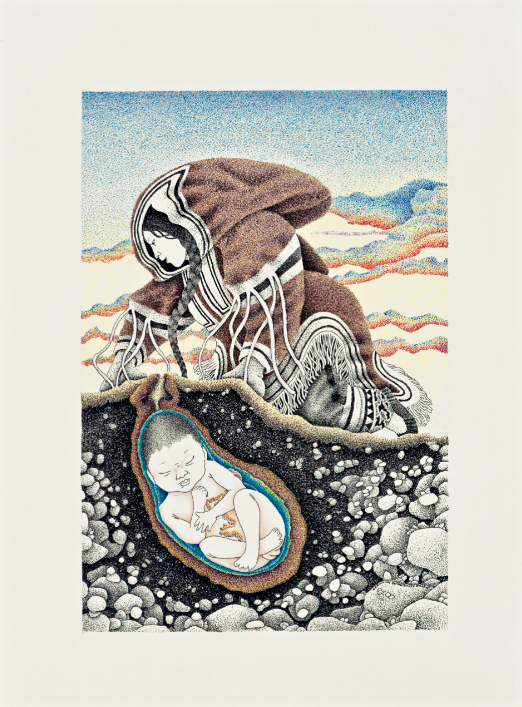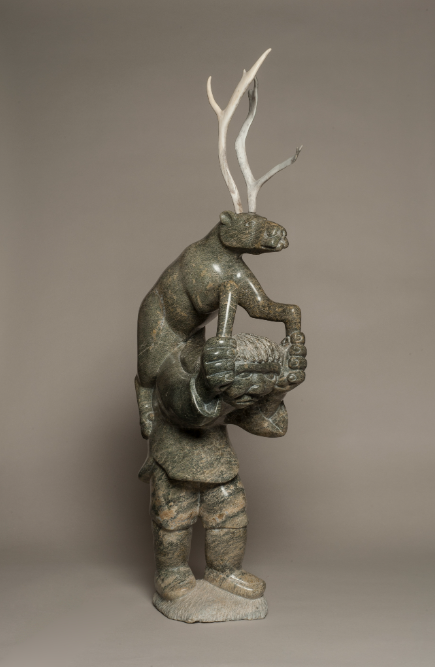New exhibition features 2000 years of Inuit art from Canada, Alaska, Greenland & Siberia

An ambitious new exhibition is opening April 1 at the Winnipeg Art Gallery-Qaumajuq in Canada that showcases the evolution of Inuit art over 2000 years.
“This is a real first,” Darlene Coward Wight, who curated the show with Jocelyn Piirainen, told Eye on the Arctic in a phone interview. “We’re integrating historical, as well as contemporary pieces, and we’re very proud of that.”
The nearly 400 artworks in Inuit Sanaugangit: Art Across Time date from 200 BCE to the present day and encompass mediums from sculpture, drawing, clothing, printmaking, and film.
The exhibits were chosen to represent creative expression from across Inuit Nunaat, the traditional Inuit homeland in the Arctic in Siberia, Alaska, Canada and Greenland.
“I’m hoping this will broaden people’s understanding of the cultural, geographical and artistic history of the North,” Wight said. “I don’t think the depth and breadth if it is well known.”

The WAG houses a contemporary collection, so sourcing older pieces involved intense research, and Wight said seeing how these objects ended up in conversation with more contemporary works was eye-opening.
“It was a learning experience trying to figure out what was created in these early periods,” Wight said. “But much of what we chose was really relevant to today.
“For example, we have a beautiful, very, very early sewing or needle case and we have contemporary needle cases in our collection. So it’s interesting to go back and, and just see the similarities in the objects.”
Canadian works are further divided geographically by the four Inuit regions in Canada: the Inuvialuit Settlement Region in Canada’s Northwest Territories; Canada’s eastern Arctic territory of Nunavut; Nunavik in northern Quebec; and Nunatsiavut, in the Atlantic Canadian province of Newfoundland and Labrador.

And if choosing the older works was challenging, Wight said going into the WAG’s collection of 28,000 works of contemporary and modern Canadian art was just as daunting.
“There’s many different themes going on in the exhibition,” she said. “It was difficult to decide what to pick. In the end we didn’t want to just focus on a few artists, but focus on one or two works from a number of artists we felt were important.”
Works by more than 90 contemporary artists were chosen, including everyone from Nunavut artists Annie Pootoogook and Jutai Toonoo to Nunavik artist Syollie Amitu and Inuvialuit artist Abraham Anghik Ruben.
Inuit Sanaugangit: Art Across Time runs from April 1, 2023 – January 7, 2024.
Write to Eilís Quinn at eilis.quinn(at)cbc.ca
Related stories from around the North:
Canada: Toronto gallery next stop for travelling Kenojuak Ashevak exhibition, Eye on the Arctic
Norway: Certification marks help both Sami artisans and consumers, says council, Eye on the Arctic
Russia: German project to house everything published in Siberian and Arctic languages to seek new funding, Eye on the Arctic
Sweden: 2022 Gollegiella Nordic Sami language prize awarded in Stockholm, Eye on the Arctic
United States: How Inuit culture helped unlock power of classical score for Inupiaq violinist, Eye on the Arctic



